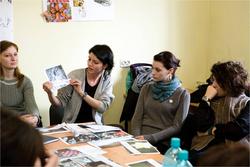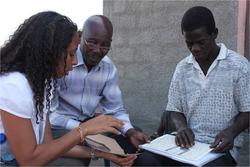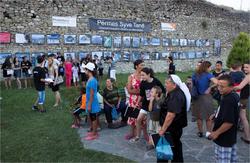Matt Daw
(Projects Manager, PhotoVoice)
I'm the chairperson of HVPN UK - the UK support charity for the Hindu Vidyapeeth Schools in Nepal. The first time, 12 years ago, when I visited Nepal, is when I saw the schools in action. The philosophy on which they are grounded had a huge impact on me - the idea particularly that people are not just individuals but they are part of something wider, that is, society and even beyond that, the higher consciousness.
There is evidence of this philosophy at PhotoVoice where I am the Projects Manager. It is a UK based international charity that has been in existence for 12 years. The organisation's vision is for a world in which no one is denied the opportunity to speak out and be heard.
The charity promotes participatory photography – photography by people who are the subjects of the photos and who are affected by the issues. This is opposite to the traditional photo journalism model where photographs are taken by those who are outside the context, often from the rich West, of people and situations who are not generally given the voice themselves. These photographs are taken from the perspective of the outsider, whereas participatory photography reverses this and allows people to tell their own stories and choose how they are represented.
PhotoVoice works with communities who are too rarely heard from regarding issues that affect them most, or who are marginalised because of society’s attitude toward them. We work with people to train them to use photographs to communicate their situations and the messages they want to share. Our participants create captioned photographs that convey these messages to people who may not be aware of their existence or their experiences, and certainly not open to what it is they have to say.
The projects are very different from one another, being located across the world and working with a huge range of issues. Examples include mental health service users, refugees, street children, HIV-affected communities and those who have been marginalised due to their social status or for political reasons.
Every project, although each very different, has at its core a certain number of key components. Firstly, the participators are helped to understand how photographs communicate, how a narrative is created and how understanding and empathy is generated through seeing still images. Secondly, visual literacy exercises are used to stimulate discussion with the group and the community. People generally find it easier to discuss observations and personal insights with the help of photographs and images.
The participators are then taught how to use and create photographs and to plan their composition. Technical training is also given on how to use digital cameras. This is especially important for international projects where the participants have often never had the opportunity to use cameras before. PhotoVoice are also experts at enabling people to use photography regardless of any obstacles such as disability, illiteracy, blindness or partial sightedness. Work with the blind and partially sighted has provided this section of society with the ability to share their experience and join in communicating visually.
The charity provides support for the participants to create their own personal photo project focusing on their own priorities and experiences. Making the choices required to create a single still image requires a certain amount of self-reflection, and participants not only learn how to communicate through photographs, but also discover what they feel and want to say. The photos they produce are then shown and discussed back in the group and with the PhotoVoice facilitators, where all these decisions and the thought behind them can be unpacked for a hugely revealing and constructive dialogue around the issues. Self-reflection, self-examination, and communication is not something that would necessarily happen in group discussion, however it is facilitated by the photographic process. It is a very revealing and productive procedure.
The editing process comes next and this involves selecting the images to be used for public output. In some projects there may be targeted audiences or there may be an aim to feed the voices of those affected into the decision-making or policy-making process. Additionally, it may be to change attitudes in communities where these people are marginalised.
The last stage is dissemination where the voices are carried to the wider public. This is often families, friends and local communities but sometimes it is much wider than that. There is generally an exhibition of the photographs at a community level which is particularly important for validating the voices and increasing the status of those voices in the eyes of others. For example, in Albania the status of the disabled is very low, especially for disabled young people who are kept at home and not supported to attend school. Our project allowed them to share their experiences and perspectives with the wider community, who were confronted with the reality that these young people are talented, able young people who just need the opportunity to contribute and create. This had a huge positive impact at local community level. Exhibitions are the most obvious method of celebrating the participant’s achievements but social media and on-line communities are also used to very good effect. Digital photographs are an extremely versatile tool for communication, since they can be displayed, projected, printed in books and postcards, emailed, shown online and more.
Participatory photography is used because it allows reflective study, participants can take control over their representation and can challenge how they are perceived and shown in the media. It also helps to break the cycle where representation leads to issues being perpetuated. It encourages self-explanation and self-expression. Participants find confidence in their own voice, challenge perceptions and create change. Examples of this work can be viewed on the website www.photovoice.org
In conclusion, the work of participatory photography is very important because it helps to shatter the illusions that are created at every level of society both locally and internationally. The predominant narratives created by the media or simply by the ‘loudest voices’ in society are often what people accept as truth. Participatory photography provides opportunities for issues to be explored and given a voice at their grass roots which creates a diversity of narrative. Through that diversity of perspectives the complex reality can emerge, as opposed to a single curated narrative that reflects only one perspective. The audience is given the same opportunity as someone witnessing or experiencing something directly – the chance to decide for themselves what they think or feel about the situation.



